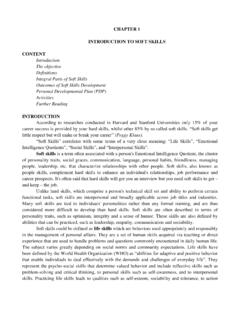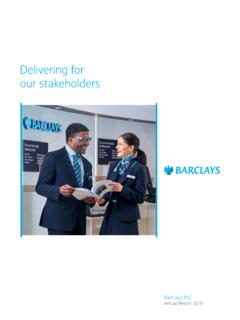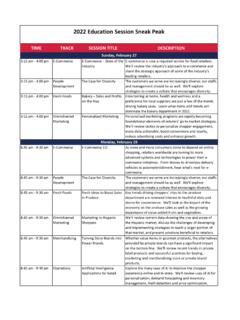Transcription of Organizational Design - Tutorialspoint
1 Organizational Design 0 Organizational Design 1 About the Tutorial Organizational Design is a sequential method of identifying the performing aspects and liabilities in a system, so that they can be re-aligned as per the needs of the company in terms of the current goals as well as implementing new business changes. Organizational Design focuses more on improving the technical and interpersonal side of the workplace. Implementing an efficient Organizational Design leads to a more effective organization, a more focused workforce, and a workplace of better productivity. In this tutorial, we will discuss in detail about the advantages of an Organizational Design and how it makes a company more efficient and productive. Audience Organizational Design is mostly studied by entrepreneurs or by managers who have been newly appointed to their posts, because it gives them an insight into the workings of different departments, their goals and how to engage with them.
2 Prerequisites Before proceeding with this tutorial, you are expected to have a basic understanding of corporate hierarchy, how operations are run within an organization and the Reward & Incentive process of companies. Copyright & Disclaimer Copyright 2022 by Tutorials Point (I) Pvt. Ltd. All the content and graphics published in this e-book are the property of Tutorials Point (I) Pvt. Ltd. The user of this e-book is prohibited to reuse, retain, copy, distribute or republish any contents or a part of contents of this e-book in any manner without written consent of the publisher. We strive to update the contents of our website and tutorials as timely and as precisely as possible, however, the contents may contain inaccuracies or errors. Tutorials Point (I) Pvt. Ltd. provides no guarantee regarding the accuracy, timeliness or completeness of our website or its contents including this tutorial. If you discover any errors on our website or in this tutorial, please notify us at Organizational Design 2 Table of Contents About the Tutorial.
3 1 1 Prerequisites .. 1 Copyright & Disclaimer .. 1 Table of Contents .. 2 1. Organizational Design INTRODUCTION .. 3 2. ORGANIZATION Design EVOLUTION .. 6 What are Organizations? .. 7 3. Organizational Design COMMON FORMS .. 10 Functional Organizational Design Model .. 10 Geographical Organizational Design Model .. 11 Product-oriented Organizational Design Model .. 12 Market-oriented Organizational Design Model .. 12 Matrix Structure Organizational Design Model .. 13 4. FACTORS INFLUENCING ORGANIZATION Design .. 15 5. Organizational Design CASE STUDY 1 .. 16 6. Organizational Design CASE STUDY 2 .. 18 7. Organizational Design WORKSHEET .. 20 8. Organizational Design CASE STUDY 3 .. 24 Organizational Design 3 Organizational Design is a sequential method of identifying the performing aspects and liabilities in a system, so that they can be re-aligned as per the needs of the company, such as current goals and implementing new business changes. It focusses on improving technical and interpersonal side of the workplace.
4 Implementing an efficient Organizational Design leads to a more effective organization, a more focused workforce and a workplace of better productivity by improving internal operations, inter-departmental relationships, working efficiency, all of which leads to better productivity and customer satisfaction. During the implementation of Organization Design , a management may enforce numerous strategic changes as per their strategy to deliver the desired results. In this process, there are chances of clashes between work-processes and the occasional trade-offs. Sometimes, there will be situations where the management realizes that they have to sacrifice smaller benefits to ensure larger benefits in the future. Due to these reasons, changes in Organizational Design are always not as smooth as the management will like them to be. However, successful companies have managed to implement such changes with an eye on the big picture and have communicated their strategies with transparency to their employees, which has helped them to bring future-embracing changes in their structure without getting any negative press or reputation to their names.
5 1. Organizational Design Introduction Organizational Design 4 Example A notable example would be the Belgian giant, DuPont that decided to enter into the international market and diversify its business in 1921. To ensure that these ventures remain profitable, they implemented changes to many fundamental structures of their management, thereby bringing a new structure to their working, which has held them high through all the effects of the fluctuating global economy. This case will be explored in greater detail in a case study. Designing changes in any organization is a step-by-step process and involves focusing on different phases of planning. In the first phase, people develop a vision for their company for the future. Once that s done, they identify their goals and the areas that they need to bring changes in to reach these goals. The next step involves drawing out a clear set of objectives and what changes to implement, so that these objectives are realized.
6 This is followed by a crucial phase called Organizational Grouping during which the management decentralizes their workforce and divides them into separate groups that take care of different departments with enough autonomy to take their own decisions, with clear and timely communication with interlinked departments. Defining Organizational Design Organization Design is a framework architecture for an organization according to which an organization runs its business. It structures the workforce and the management in the most efficient working method through which they can realize their company s mission statement. A successful and comprehensive Design process is defined by the holistic approach it envisions for the Organizational improvement. To Design such a framework that addresses all the vital areas of a company, the management will have to draw objectives that ensure the following: Business Growth Model Improved Efficiency and Profits Outstanding Customer Service Improved Process Management President George H.
7 W. Bush had once asked a friend to help him identify some pressing issues for the election campaign, who suggested that he go alone to Camp David for a few days and figure out what direction he wants to lead the country towards, an incensed Bush told, Oh, the vision thing." This exposed his inability to articulate important policies in a concise manner. He was one of the few incumbent US presidents who didn t win a second term. Can you guess why? Organizational Design 5 Improved Workforce Productivity Decreasing Operational Expenses Improved Employee Engagement Based on this framework, work is deployed, teams are formed, responsibilities are delegated and core values are implemented. As a result of this, high-quality output is produced, which is then offered to the clients. Following this chain of operations for every project ensures trust, quality-assurance, time-efficiency and more business. However, unlike what many people assume, there is no particular super- Design that fits all.
8 In fact, companies have lost their fortunes and brought severe losses upon themselves in chasing after the elusive formula that will set everything in order for them. They kept implementing repeated changes in their organization s structure, but didn t end up improving their business. Organizational Design 6 Many people mistake Organization Design with Organizational Structure. In this chapter, we will understand the difference between both. Organizational Structure Organizational Structure is related to mapping out the different departments of an organization and the different teams working in each department, their hierarchical order, their goals and objectives. It also illustrates the roles and responsibilities given to different responsibilities. A typical Organization Structure illustration looks like the following illustration: 2. Organization Design Evolution Organizational Design 7 Organizational Design On the other hand, Organizational Design is related to aligning functions, processes, strategies, responsibilities and roles to different members of team and departments within the context of the various processes and products that the company produces.
9 What are Organizations? When asked to imagine an Organization, people tend to picture a big glass building in a big campus with state-of-art facilities, bright corridors and teams upon teams of people working on different floors. It brings a surprised look in their eyes when they are told that every one of them has worked in an organization irrespective of the fact that they have ever stepped inside an office or not in their entire lives. If you are surprised too, then you are in a good company, because people relate to organizations with names like UNO, World Bank. This issue arises from a fundamental misunderstanding in the meaning of the term Organization. We know that organizations consist of people working in big buildings. However, it is interesting to think if the buildings themselves are a part of the organization, even if the company owns it. The answers to such questions were answered up to a great extent by Jim McNamara, who said that an organization in its most basic definition can apply to a single person too.
10 According to him, an organization is either a person or group of people with an organized approach to complete an individual or collective goal with either an individual reward or collective reward in expectation. Mission and Vision The mission of any organization is identifying and conceptualizing the common purpose that binds the team-members together as one enterprise. This mission statement is often shared between members of the company and stakeholders to make them aware of the purpose and objectives of the organization. Organizational Design 8 There is a difference between Mission and Vision, though. Vision: A Vision or Vision Statement tells what an organization should achieve and be in (n) years. It is related to trying to accurately predict the future of business and make preparations from now on. It tries to set a benchmark that the organization is supposed to achieve in a given number of years. Companies without a vision are perceived as self-centered who are resistant in adopting to change with passage of time.













